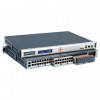Lantronix SLC 8000 Advanced Console Manager User Guide - Page 271
Shutdown Both SLC UPSes, Provides SLC Power
 |
View all Lantronix SLC 8000 Advanced Console Manager manuals
Add to My Manuals
Save this manual to your list of manuals |
Page 271 highlights
10: Remote Power Managers BOOST - UPS is boosting incoming voltage FSD - UPS is in forced shutdown due to a critical condition Once a UPS is on line power (status is OL) and goes off of line power and onto battery power (status is OB), it may reach a low battery state (status is OB, LB or LB). Switching from line power to battery power, and reaching a low battery state are critical states that can result in syslog, email and SNMP trap notifications. The exact point at which a UPS reaches a low battery state is device dependent and is related to the battery.charge, battery.charge.low, battery.runtime and battery.runtime.low settings which can be viewed in the "Raw Data" report. Once a UPS reaches a low battery state, the Shutdown Order, Low Battery Action and Provides SLC Power settings determine which UPSes to shutdown, and in what order. The UPS with the low battery will be placed into FSD (Forced Shutdown) mode. The following actions will be performed based on the Low Battery Action setting for the UPS with the failed battery: Allow Battery Failure - The UPS battery will be allowed to run until it fails completely. If the UPS provides power to the SLC and the battery fails, the SLC will not be cleanly shutdown. In this scenario, the Shutdown Order setting will be ignored. The Shutdown Order setting may be used if another UPS reaches the low battery state (see Shutdown all UPSes below). Shutdown This UPS - If the UPS provides power to the SLC, the SLC will begin shutdown procedures, shutting down the UPS last. If the UPS does not provide power to the SLC, the UPS will be shutdown, but will continued to be monitored in case it comes back online. Shutdown all UPSes - The SLC will begin shutting down all UPSes with a non-zero Shutdown Order, shutting down UPSes with a shutdown order of "1" first, UPSes with a shutdown order of "2" second, etc. Any UPS which provides power to the SLC is always forced to have its Shutdown Order set to 50, which the highest (and last) Shutdown Order. If the UPS with the failed battery provides power to the SLC (and thus has a Shutdown Order set to 50), the SLC will also begin shutdown procedures, shutting down the failed UPS last. If none of the UPSes provide power to the SLC, after they are all shutdown their drivers will remaining running in case the UPS comes back online. In this case, any queries to an RPM while it is still offline may report "RPM driver data is stale". If the Low Battery Action for a UPS is set to Allow Battery Failure, but the UPS has a non-zero Shutdown Order, the UPS will still be shutdown if another UPS reaches the low battery state and has its Low Battery Action set to Shutdown all UPSes. Shutdown Both SLC UPSes - This setting should only be used on dual-power SLC units which have each power supply connected to separate (different) UPS devices, and both UPS devices are being managed by the SLC. If a UPS is configured for Shutdown Both SLC UPSes but does not have Provides SLC Power enabled, this is an ambiguous configuration, and no shutdown action will occur. For this configuration, when one of the UPSes providing power to the SLC reaches a low battery state, the event will be noted in the system log, and the SLC will continue to run with no further actions until the second UPS providing power to the SLC reaches a low battery state. At this point the SLC will begin shutdown procedures, shutting down both failed UPSes last. SLC™ 8000 Advanced Console Manager User Guide 271















